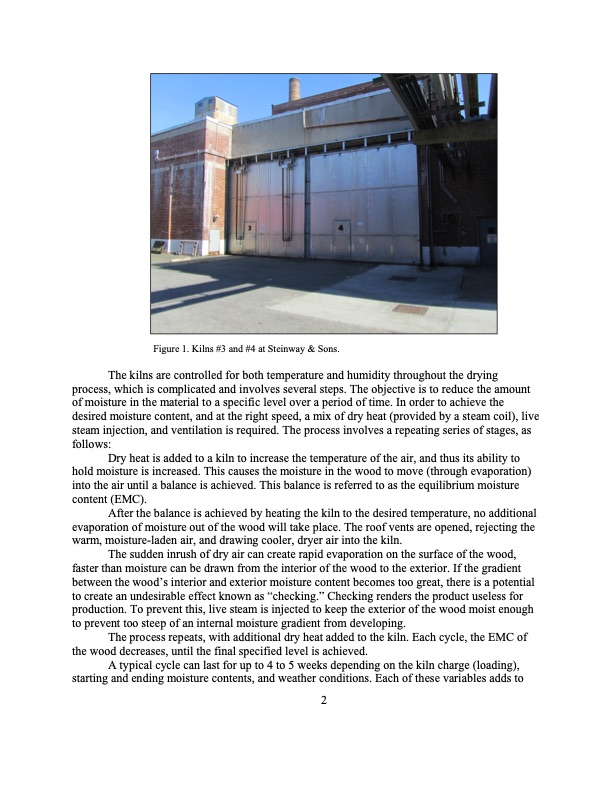
PDF Publication Title:
Text from PDF Page: 002
Figure 1. Kilns #3 and #4 at Steinway & Sons. The kilns are controlled for both temperature and humidity throughout the drying process, which is complicated and involves several steps. The objective is to reduce the amount of moisture in the material to a specific level over a period of time. In order to achieve the desired moisture content, and at the right speed, a mix of dry heat (provided by a steam coil), live steam injection, and ventilation is required. The process involves a repeating series of stages, as follows: Dry heat is added to a kiln to increase the temperature of the air, and thus its ability to hold moisture is increased. This causes the moisture in the wood to move (through evaporation) into the air until a balance is achieved. This balance is referred to as the equilibrium moisture content (EMC). After the balance is achieved by heating the kiln to the desired temperature, no additional evaporation of moisture out of the wood will take place. The roof vents are opened, rejecting the warm, moisture-laden air, and drawing cooler, dryer air into the kiln. The sudden inrush of dry air can create rapid evaporation on the surface of the wood, faster than moisture can be drawn from the interior of the wood to the exterior. If the gradient between the wood’s interior and exterior moisture content becomes too great, there is a potential to create an undesirable effect known as “checking.” Checking renders the product useless for production. To prevent this, live steam is injected to keep the exterior of the wood moist enough to prevent too steep of an internal moisture gradient from developing. The process repeats, with additional dry heat added to the kiln. Each cycle, the EMC of the wood decreases, until the final specified level is achieved. A typical cycle can last for up to 4 to 5 weeks depending on the kiln charge (loading), starting and ending moisture contents, and weather conditions. Each of these variables adds to 2PDF Image | Quick-dry Partial Vacuum System

PDF Search Title:
Quick-dry Partial Vacuum SystemOriginal File Name Searched:
Kiln-Upgrade-Study-at-Steinway.pdfDIY PDF Search: Google It | Yahoo | Bing
5,000 BF Shipping Container Lumber Dry Kiln For Quality Lumber The 5,000 BF container kiln consists of one 40 foot high-cube aluminum shipping container... More Info
Shipping Container Lumber Dry Kilns by Global Energy Global Energy designed and developed the container kiln back in 1991. The purpose is to give access to portable sawmill owners, furniture makers, and small business the value added profit of dry kiln lumber and quality hardwoods... More Info
Vacuum Kiln Conversion Kit for Lumber and Wood Dry Kilns Convert your existing conventional dry kiln into a fast drying vacuum kiln. Similar to vacuum bagging in the boat building and aircraft industry, we have come up with a proprietary process which allows you to build a very simple vacuum kiln at a fraction of the price, and without the intensive conventional metal chamber structure... More Info
Vacuum Pump Cart System for Bagging Clamping Wood Drying and more Vacuum Cart with 2HP Pump and Dual Pistons with multiple multiplex vacuum ports and liquid reservoir... More Info
Vacuum Bagging Basics Vacuum bagging is a method of clamping, which has traditionally been used in the composites industry, but can also be used for vacuum drying materials, including wood products... More Info
| CONTACT TEL: 608-238-6001 Email: greg@globalmicroturbine.com | RSS | AMP |